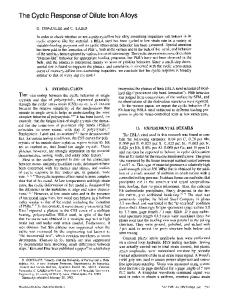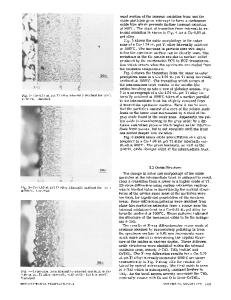Spin-Polarized Relativistic Band Structure Calculations for Dilute and Concentrated Disordered Alloys
- PDF / 706,975 Bytes
- 12 Pages / 420.48 x 639 pts Page_size
- 76 Downloads / 360 Views
SPIN-POLARIZED RELATIVISTIC BAND STRUCTURE CALCULATIONS FOR DILUTE AND CONCENTRATED DISORDERED ALLOYS H. EBERT * AND H. AKAI ** Siemens AG, Central Research Laboratories, ZFE BT MR 11, Postfach 3220, D-8520 Erlangen, FRG. ** Department of Physics, Nara Medical University Kashihara, Nara 634, Japan ABSTRACT Applications of the spin-polarized relativistic version of multiple scattering theory (SPRKKR) to study the electronic properties of dilute and concentrated disordered alloys are presented. This approach, developed recently, allows to investigate magnetic systems containing heavy elements and also gives access to a detailed discussion of phenomena, which are linked to the simultanous presence of spin-polarisation and spin-orbit coupling. This is demonstrated by discussing the hyperfine properties of 5d-transition metals dissolved substitutionally in Fe, where pronounced relativistic effects could be found. In addition the magnetic X-ray dichroism (MXD), denoting the difference in absorption of left and right circularly polarized radiation, is studied for these dilute alloys. To be able to deal also with concentrated alloys, we have combined the Coherent Potential Approximation (CPA) alloy theory with the SPRKKR-formalism. Results for the spin-orbit induced orbital contributions to the magnetic moments as well as the MXD in Fe=Col-i and Co.Ptl-s clearly show that remarkable relativistic effects are present even for relatively light elements. INTRODUCTION There are quite many physical effects which are caused by the simultanous occurence of spin-orbit coupling and spin polarisation in solids and which are of scientific as well as technological interest. Recently, various band structure methods (KKR, LMTO, ASW and LCAO; see e.g. [1]) have been generalized to deal with this complicated situation in a rigorous way. Among these methods the multiple scattering technique (KKR) in connection with the Green's function formalism (KKR-GF) has the great advantage to combine high numerical accuracy with great flexibility, which allows to study systems without translational symmetry. The basis for corresponding spin polarized relativistic SPRKKR calculations is shortly sketched together with the formalism to treat dilute and - within the Coherent Potential Approximation (CPA) - concentrated alloys. As applications of this approach we present a study of the impact of relativistic effects on the properties of 5d-impurity atoms in bcc-Fe and of the alloy systems bcc-Fe.Col_= and fcc-CoPtl-i.
THEORETICAL FRAMEWORK The problem of finding a correct relativistic description of the ground state of a many electron system has been discussed in the past by several authors (see e.g. [2] and references therein). Analogous to the non-relativistic case a system of coupled Kohn-Sham-Diracequations has been derived, where the electronic current density replaces the spin density as the central quantitiy. However, because this rigorous scheme is too difficult to handle, an Mat. Res. Soc. Symp. Proc. Vol. 253. @1992 Materials Research Society
3
Data Loading...











